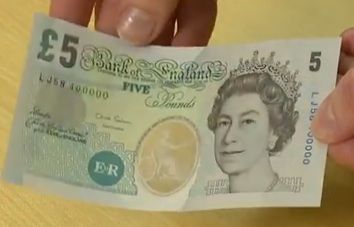Plastic banknotes will replace the current cotton paper £5 and £10 ones, the Bank of England has announced. Banknotes means paper money, which in the UK includes £5, £10, £20 and £50.
The new plastic banknotes will be printed on polymer, a thin and flexible plastic film that resists washing machine cycles and lasts much longer.
The Bank of England (BoE) says the new plastic banknotes will still retain the familiar look of the current cotton-paper money “including the portrait of Her Majesty the Queen and a historical character.”
 The £5 notes will feature Winston Churchill.
The £5 notes will feature Winston Churchill.
The first plastic banknote, to be issued in 2016, will be a £5 note with a portrait of Sir Winston Churchill. The £10 note will come in 2017 and will feature Jane Austen.
Why are the plastic banknotes better?
The BoE gave the following compelling reasons for printing on polymer, after a 3-year research program:
- Plastic banknotes are resistant to moisture and dirt, they stay cleaner much longer than cotton paper ones.
- Polymer banknotes are much more difficult to counterfeit, they incorporate advanced security features.
- Plastic banknotes last much longer, about 2.5 times longer than the current ones.
The BoE added that the polymer plastic banknotes are more environmentally friendly, because they last longer and are cheaper to make than the paper ones. Also, they are thin and flexible, making it easier to fit them into wallets and purses.
 The £10 notes will feature Jane Austen.
The £10 notes will feature Jane Austen.
UK general public responded well to the new notes
In September 2013, as part of its research program, the central bank had said that it would only introduce the plastic banknotes if the general public approved, which they did overwhelmingly.
For two months the BoE held events across the country1, giving people the opportunity to learn more about polymer banknotes. The public consultation program, which triggered nearly 13,000 feedbacks, showed that 87% of respondents were in favor of the new plastic banknotes, while 6% did not like it and 7% were neutral.
Positive feedback was seen across the socioeconomic spectrum and all regions of the country. “The most notable difference in feedback was that people who had the opportunity to see and handle the notes were 20% more likely to support polymer than those responding on the internet.”
 Feedback across the country was overwhelmingly positive.
Feedback across the country was overwhelmingly positive.
As well as the general public, the Bank also consulted with a broad range of stakeholders in the cash industry. “A new polymer note would require greater change to cash handling practices than a new paper note so the Bank will continue its dialogue with the industry and work collaboratively towards a smooth introduction of the first polymer note. The Bank will host an Industry Forum in February 2014 to initiate this work.”
The new plastic banknotes will be slightly smaller than the current cotton paper ones, however, note denomination will be associated with size, i.e. the ten pound notes will be bigger than the five pound ones, as is the case with the paper notes.
Plastic banknotes will be smaller
UK paper money is currently larger compared with notes in other currencies, making them harder to fit into internationally-sized wallets and some exchange devices. The BoE added that smaller bills will reduce storage and printing costs.
 All the notes will feature Her Majesty The Queen, like the current ones.
All the notes will feature Her Majesty The Queen, like the current ones.
The BoE wrote in a communiqué:
“The contract for printing the Bank of England’s notes from April 2015 is currently being tendered. Notes will continue to be printed at the Bank’s printing works in Debden, Essex. The Bank expects to enter a contract with Innovia Security to supply the polymer material for the new-style £5 and £10 notes, in which case Innovia would establish a polymer production plant in Wigton, Cumbria, in 2016.”
Mark Carney, Governor of the BoE, said:
“Ensuring trust and confidence in money is at the heart of what central banks do. Polymer notes are the next step in the evolution of banknote design to meet that objective. The quality of polymer notes is higher, they are more secure from counterfeiting, and they can be produced at lower cost to the taxpayer and the environment.”
Executive Director for Banking Services and Chief Cashier, Chris Salmon, said:
“We are grateful to the thousands of people who came to talk to us about polymer banknotes. We know that the public care greatly about their banknotes and the feedback we received provided an invaluable input into our final decision.”
The BoE says the issue of the new plastic banknotes will be backed up with “a comprehensive education program,” including details on how the current notes will be withdrawn from circulation.

